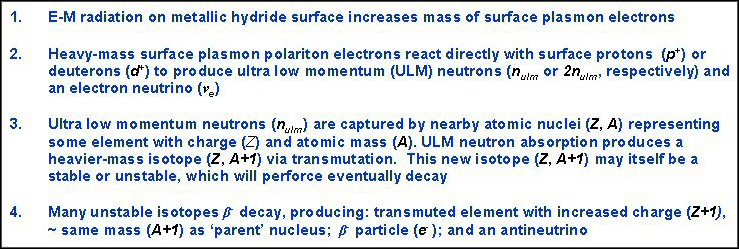|
⇐ Previous Article — Table of Contents — Next Article ⇒
New Energy Times home page
13. Widom-Larsen Theory Simplified
By Steven B. Krivit
(Source: New Energy Times)
For several years, Lewis Larsen has been prolific in his written communications about his and Allan Widom's theory of ultra-low-momentum, neutron-catalyzed, low-energy nuclear reactions. Most of Larsen's science papers, news articles, and slide presentations are listed on the New Energy Times Widom-Larsen Theory Portal.
This article will present the simplest possible overview of the Widom-Larsen theory of LENRs. In order to keep this article as concise as possible, I will begin it at a level that assumes readers have some basic understanding of nuclear physics. This article will also go relatively quickly from simplicity to a highly complex overview of the potential implications and applications of not only the Widom-Larsen theory but also of LENR.
The Widom-Larsen ultra-low-momentum neutron-catalyzed theory of LENRs involves four fundamental steps, as shown graphically in Larsen's image (Figures 1 and 2) below:
Figure 1: Four steps of Widom-Larsen theory. Figure 2: Legend
Summaries of the four steps follow:
(Source: New Energy Times)
1. Creation of Heavy Electrons
Electromagnetic radiation in LENR cells, along with collective effects, creates a heavy surface plasmon polariton (SPP) electron from a sea of SPP electrons.
2. Creation of ULM Neutrons
An electron and a proton combine, through inverse beta decay, into an ultra-low-momentum (ULM) neutron and a neutrino.
3. Capture of ULM Neutrons
That ULM neutron is captured by a nearby nucleus, producing, through a chain of nuclear reactions, either a new, stable isotope or an isotope unstable to beta decay.
A free neutron outside of an atomic nucleus is unstable to beta decay; it has a half-life of approximately 13 minutes and decays into a proton, an electron and a neutrino.
4. Beta Decay Creation of New Elements and Isotopes
When an unstable nucleus beta-decays, a neutron inside the nucleus decays into a proton, an energetic electron and a neutrino. The energetic electron released in a beta decay exits the nucleus and is detected as a beta particle. Because the number of protons in that nucleus has gone up by one, the atomic number has increased, creating a different element and transmutation product.
In the graphic above, step 2 is listed twice: 2a depicts a normal hydrogen reaction, 2b depicts the same reaction with heavy hydrogen. All steps except the third are weak-interaction processes. Step 3, neutron capture, is a strong interaction but not a nuclear fusion process. (See "Neutron Capture Is Not the New Cold Fusion" in this special report.)
Given that the fundamental basis for the Widom-Larsen theory is weak-interaction neutron creation and subsequent neutron-catalyzed nuclear reactions, rather than the fusing of deuterons, the Coulomb barrier problem that exists with fusion is irrelevant in this four-step process.
The most unusual and by far the most significant part of the Widom-Larsen process is step 1, the creation of the heavy electrons. Whereas many researchers in the past two decades have speculated on a generalized concept of an inverse beta decay that would produce either a real or virtual neutron, Widom and Larsen propose a specific mechanism that leads to the production of real ultra-low-momentum neutrons.
Larsen also provides a more technical explanation of the four steps in his slides: |



